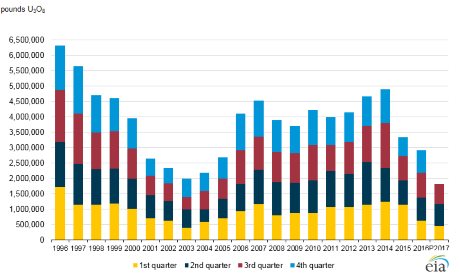US uranium production for 2017 to date is down 17% from the same period in 2016, according to the US Energy Information Administration's (EIA) latest quarterly Domestic Uranium Production Report. Meanwhile, the US Geological Survey (USGS) has found uranium-bearing calcrete formations in the USA for the first time.
 |
| US uranium concentrate production from 1996 to the third quarter of 2017 (Image: EIA) |
Seven US facilities produced a total of 643,212 pounds U3O8 (247 tU) during the third quarter of 2017. These facilities included one conventional uranium mill - the White Mesa mill, in Utah - and six in-situ leach facilities: Crow Butte, in Nebraska; and Lost Creek, Nichols Ranch, Ross, Smith Ranch-Highland and Willow Creek, all in Wyoming. Production was 11% less than in the second quarter of 2017 and 21% less than for the third quarter of 2016.
Total uranium production for the first three-quarters of 2017 was 1.82 million pounds U3O8, down 17% from the 2.19 million pounds produced in the first three-quarters of 2016.
According to the EIA, production of uranium concentrate at the USA's only operating conventional uranium mill - Energy Fuels' White Mesa - was not from the milling of uranium ore, but from other (non-ore) materials. The mill, which has a licensed capacity of over 8 million pounds of uranium per year, has a separate alternate feed circuit to produce uranium from uranium-bearing materials other than ore with grades as high as 75% U3O8. Such materials may come from uranium conversion and other metals processing, and the mill also has the ability to process material generated from land cleanup work.
In its own third quarter results, published on 2 November, Energy Fuels said White Mesa's ability to generate cash from the processing of alternate feed materials make it a key part of the company. The company said it is "actively pursuing other revenue generating opportunities", including processing new and additional alternate feed sources, to allow the mill to extend its current processing campaign into 2018 and beyond.
High Plains uranium
The Southern High Plains region of Texas, New Mexico, and Oklahoma could contain potential undiscovered uranium resources of about 40 million pounds of uranium oxide, according to a study released on 14 November by the USGS. This would be enough to meet nearly a year of domestic US uranium requirements.
The uranium occurs in calcrete rock formations. Such formations have been well-documented in uranium-producing countries such as Australia and Namibia, but the formations described in this assessment are the first uranium-bearing calcrete deposits reported in the United States, the USGS said.
"Planning for long-term sustainable nuclear power in the United States requires evaluation of both identified and potential undiscovered resources," Tom Crafford, USGS Mineral Resources Program coordinator, said. "Identifying and understanding our domestic mineral wealth is a vital part of ensuring the security of our supply chain for these resources," he added.
The assessment of the Southern High Plains also saw the discovery of a new uranium mineral species. Discovered near Sulphur Springs Draw in Texas, the new mineral was named finchite, after USGS uranium scientist Warren Finch (1924-2014).
Researched and written
by World Nuclear News





_28178.jpg)
_66891.jpg)
_16128_62584.jpg)





